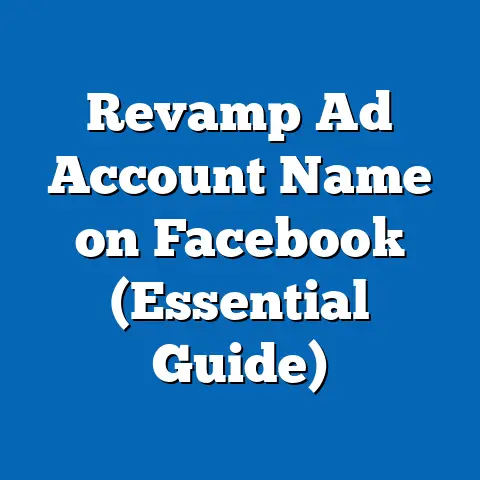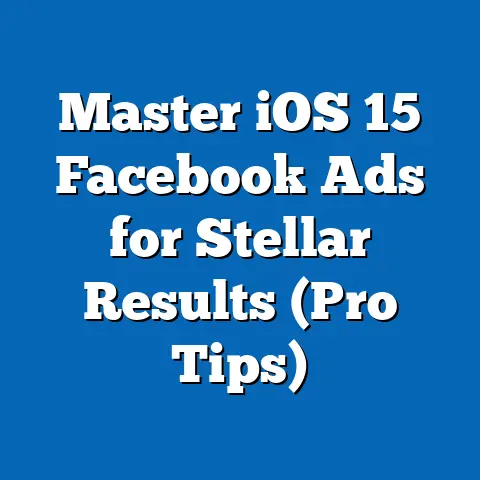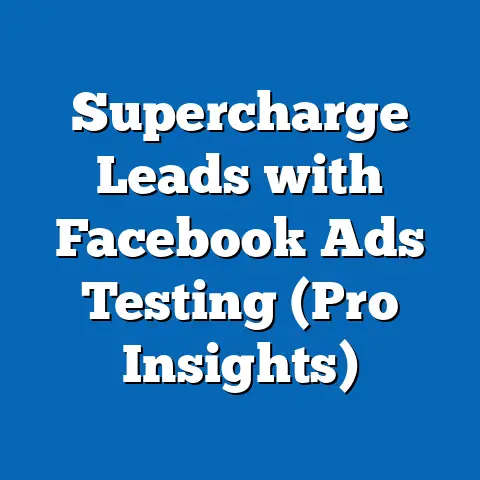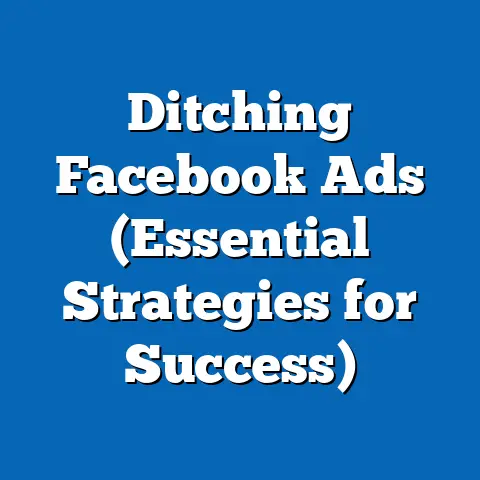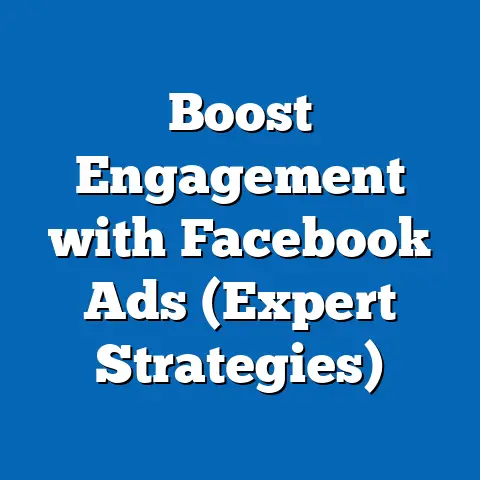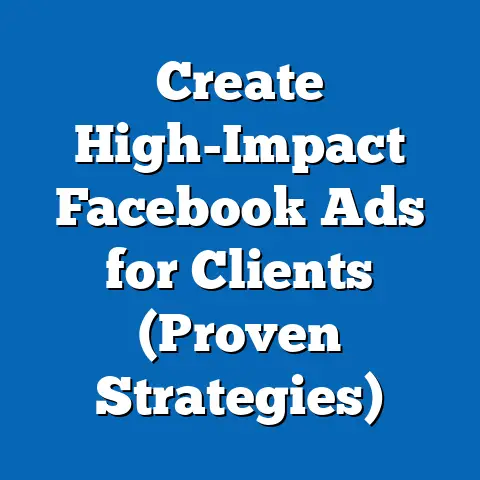Master Auction Overlap in Facebook Ads (Proven Strategies)
Did you know that, according to a 2022 study by Social Media Today, nearly 60% of advertisers on Facebook experience auction overlap, where their own ad sets compete against each other for the same audience, inadvertently driving up costs and reducing campaign efficiency? Auction overlap is a critical yet often overlooked challenge in the realm of Facebook advertising, where multiple ad sets within a single account or across accounts target overlapping audience segments, leading to internal competition in the ad auction process. This phenomenon can significantly impact return on ad spend (ROAS), with some advertisers reporting cost-per-click (CPC) increases of up to 30% due to unchecked overlap.
Understanding and mitigating auction overlap is not merely a technical necessity but a strategic imperative for digital marketers aiming to maximize their advertising budgets. Historically, as Facebook’s advertising platform evolved from a rudimentary system in the late 2000s to a sophisticated, AI-driven ecosystem by the 2020s, the complexity of audience targeting and ad delivery has grown exponentially. This evolution has brought both opportunities for precision and pitfalls like auction overlap, which emerged as a byproduct of granular targeting options and the platform’s competitive auction model.
Defining Auction Overlap: Key Characteristics and Mechanics
Auction overlap on Facebook occurs when two or more ad sets from the same advertiser (or sometimes across different advertisers) target overlapping audience segments, causing them to compete in the same ad auction. This internal competition drives up the bid price, as the platform’s algorithm prioritizes the highest effective bid, regardless of whether the competing ads originate from the same account. The result is often higher costs, lower ad delivery efficiency, and diminished campaign performance.
Key characteristics of auction overlap include audience duplication, where multiple ad sets target similar demographics, interests, or behaviors; ad set fragmentation, where campaigns are split into numerous smaller ad sets without clear differentiation; and budget inefficiency, where ad spend is diluted across competing placements. It’s critical to note that overlap isn’t always immediately apparent—Facebook’s algorithm operates behind the scenes, and advertisers may not realize their ad sets are competing until they analyze performance metrics like rising CPC or declining reach.
While overlap can occur at any scale, it is particularly prevalent among advertisers managing large campaigns with multiple objectives or those testing various audience segments without consolidation. The diversity of targeting options—such as custom audiences, lookalike audiences, and interest-based targeting—exacerbates the risk, as slight variations in targeting parameters can still result in significant audience crossover. Understanding these mechanics is the first step toward developing effective mitigation strategies.
Historical Context: The Evolution of Facebook Advertising and Auction Dynamics
To fully grasp the issue of auction overlap, it’s essential to consider the historical evolution of Facebook’s advertising platform. Launched in 2007 as a basic banner ad system, Facebook Ads initially offered limited targeting capabilities, focusing on broad demographics like age and location. During this period, auction overlap was virtually nonexistent due to the simplicity of the system and the smaller advertiser base.
By the early 2010s, as Facebook grew into a social media giant with over a billion users, the platform introduced advanced targeting options, including interests, behaviors, and custom audiences. This era also saw the rise of the ad auction model, where advertisers bid for ad placements based on audience relevance and budget. While this model democratized access to advertising by allowing smaller players to compete with larger brands, it also laid the groundwork for auction overlap as advertisers began creating multiple ad sets to test different creatives and audiences.
The mid-2010s marked a turning point with the introduction of machine learning-driven tools like Dynamic Ads and the Automated Ads feature, which aimed to optimize delivery but sometimes amplified overlap by automatically expanding audience reach. By the 2020s, with the rollout of iOS 14 privacy changes and the subsequent loss of granular tracking data, advertisers increasingly relied on broader targeting, inadvertently increasing overlap risks. This historical trajectory underscores how technological advancements, while empowering, have also introduced complexities that require strategic oversight.
Societal and Economic Implications of Auction Overlap
Auction overlap is not just a technical glitch; it has far-reaching implications for businesses, consumers, and the digital advertising ecosystem. For advertisers, particularly SMEs with limited budgets, overlap can erode profitability by inflating ad costs without delivering proportional results. A 2021 report by eMarketer found that inefficient ad spend due to issues like overlap costs U.S. businesses an estimated $5 billion annually on platforms like Facebook.
For consumers, the indirect effects manifest as higher product prices, as businesses offset rising advertising costs by increasing markups. Additionally, overlap can reduce ad diversity—if an advertiser’s budget is consumed by competing ad sets, fewer unique messages reach the audience, potentially leading to ad fatigue. This phenomenon can diminish the effectiveness of digital marketing as a tool for consumer engagement.
From a broader societal perspective, auction overlap highlights the growing complexity of digital ecosystems and the need for education and transparency in advertising practices. As platforms like Facebook wield significant influence over market dynamics, inefficiencies in their systems can disproportionately affect smaller players, exacerbating economic inequalities. Addressing overlap is thus not only a matter of campaign optimization but also a step toward fostering a more equitable digital marketplace.
Technological Factors Contributing to Auction Overlap
The root of auction overlap lies in the technological architecture of Facebook’s ad platform, particularly its auction-based delivery system. The platform uses a second-price auction model, where the winning bidder pays just above the second-highest bid, factoring in ad relevance and estimated action rates. When multiple ad sets from the same advertiser target overlapping audiences, they effectively bid against each other, driving up the effective cost even if external competition is low.
Another technological factor is the granularity of targeting tools. While options like lookalike audiences and interest stacking allow for precise audience segmentation, they also increase the likelihood of overlap if not carefully managed. For instance, creating a lookalike audience based on a custom list and simultaneously targeting a broad interest group may result in significant crossover, unbeknownst to the advertiser.
Facebook’s automated optimization tools, such as Campaign Budget Optimization (CBO), can both mitigate and exacerbate overlap. While CBO aims to distribute budget efficiently across ad sets, it may still allocate spend to overlapping segments if the audience parameters are not distinct. Understanding these technological underpinnings is crucial for advertisers seeking to navigate the platform’s complexities.
Economic and Competitive Dynamics of Overlap
Economically, auction overlap reflects the competitive nature of digital advertising, where demand for high-value audience segments often outstrips supply. Premium audiences—such as high-income demographics or niche interest groups—are frequently targeted by multiple advertisers, increasing the likelihood of overlap not just within accounts but across the platform. This competition drives up costs, with a 2023 study by WordStream reporting that CPC for competitive industries like finance and insurance can exceed $3.50 due to overlap and saturation.
For individual advertisers, overlap creates a zero-sum game within their own campaigns—budget spent on competing ad sets yields diminishing returns as impressions are split without added value. This inefficiency can be particularly detrimental in industries with tight margins, where every dollar of ad spend must generate measurable outcomes. Strategically managing overlap is thus a competitive necessity in an increasingly crowded digital space.
Proven Strategies to Mitigate Auction Overlap
Mitigating auction overlap requires a combination of strategic planning, data analysis, and ongoing optimization. Below are proven strategies that advertisers can implement to minimize overlap and maximize campaign efficiency. Each approach is grounded in practical application and supported by industry best practices.
1. Audience Segmentation and Exclusion
One of the most effective ways to reduce overlap is through deliberate audience segmentation and exclusion. Start by mapping out your target audiences and identifying potential areas of crossover—for instance, if you’re running separate ad sets for “new customers” and “returning customers,” ensure there’s no overlap by excluding one group from the other’s targeting parameters. Facebook’s audience exclusion feature allows advertisers to prevent ad sets from targeting the same users, ensuring clearer delineation.
Regularly audit your audiences using tools like Facebook’s Audience Overlap feature, which provides a percentage breakdown of shared users between ad sets. If overlap exceeds 10-15%, consider consolidating ad sets or refining targeting criteria. This proactive approach can significantly reduce internal competition and improve delivery efficiency.
2. Consolidate Ad Sets with Campaign Budget Optimization (CBO)
Campaign Budget Optimization is a powerful tool for minimizing overlap by allowing Facebook’s algorithm to allocate budget dynamically across ad sets based on performance. Instead of splitting budgets manually across multiple ad sets with overlapping audiences, use CBO to create a single campaign with distinct ad sets, letting the platform prioritize the best-performing combinations. This reduces the risk of manual misallocation and internal bidding wars.
However, CBO is not a silver bullet—it requires well-defined ad set parameters to avoid unintended overlap. Test CBO with smaller budgets initially, monitoring metrics like CPC and frequency to ensure the algorithm isn’t over-delivering to a narrow audience segment. When used correctly, CBO can lower costs by up to 20%, according to a 2022 case study by AdEspresso.
3. Leverage Broad Targeting with Machine Learning
With the decline of granular tracking post-iOS 14, many advertisers have shifted toward broader targeting, relying on Facebook’s machine learning to identify high-value users. Broad targeting reduces overlap by minimizing the number of hyper-specific ad sets, allowing the algorithm to optimize delivery across a larger pool. For instance, instead of creating separate ad sets for “dog owners aged 25-34” and “dog owners aged 35-44,” combine them into a single broad audience and let the platform refine delivery.
This strategy requires trust in Facebook’s AI, which can be a hurdle for advertisers accustomed to manual control. However, data from a 2023 report by Hootsuite suggests that campaigns using broad targeting see a 15% lower cost-per-acquisition (CPA) on average, partly due to reduced overlap. Monitor performance closely to ensure broad targeting aligns with campaign goals.
4. Schedule and Frequency Capping
Scheduling ads to run at different times or setting frequency caps can also mitigate overlap, especially for campaigns targeting the same audience with multiple messages. For example, if you’re promoting a product launch and a seasonal sale to the same demographic, schedule the product launch ads for mornings and the sale ads for evenings, minimizing direct competition. Frequency capping limits how often a user sees ads from your account, preventing overexposure and budget waste.
This approach is particularly effective for retargeting campaigns, where overlap risks are high due to smaller audience pools. A 2021 experiment by Socialbakers found that frequency capping at 3 impressions per week reduced CPC by 18% for retargeting campaigns, highlighting the value of controlled delivery.
5. Regular Performance Analysis and Iteration
Finally, continuous monitoring and iteration are essential for managing overlap. Use Facebook Ads Manager to track metrics like reach, impressions, and CPC, identifying ad sets with unusually high costs or low efficiency. Dive into the Breakdowns feature to analyze audience overlap by demographics or placement, adjusting targeting as needed.
Third-party tools like Sprout Social or Revealbot can also provide deeper insights into overlap patterns, offering automated alerts for performance anomalies. Treat overlap management as an ongoing process rather than a one-time fix—regular analysis ensures campaigns remain optimized as audience behaviors and platform algorithms evolve.
Nuances and Diversity in Auction Overlap Challenges
While the strategies above provide a robust framework, it’s important to acknowledge the nuances and diversity in how auction overlap manifests across industries, campaign objectives, and advertiser experience levels. For instance, e-commerce brands running dynamic product ads may face higher overlap risks due to the automated nature of catalog-based targeting, whereas B2B advertisers with narrow audiences might struggle with overlap due to limited user pools.
Similarly, overlap impacts vary by budget size—large advertisers with diversified campaigns may absorb cost inefficiencies more easily, while small businesses could see significant ROAS declines from even minor overlap. Geographic and cultural factors also play a role; advertisers in densely populated markets like the U.S. may encounter more competition and overlap than those in smaller regions. Tailoring strategies to these contextual factors is critical for effective overlap management.
Implications for Advertisers and the Broader Ecosystem
Addressing auction overlap has profound implications for advertisers and the digital marketing landscape. At the individual level, reducing overlap can improve ROAS, lower CPC, and enhance campaign scalability, enabling businesses to allocate budgets more strategically. For SMEs, this efficiency can be a game-changer, leveling the playing field against larger competitors with deeper pockets.
In the workplace, mastering overlap fosters a data-driven culture among marketing teams, emphasizing the importance of analytics and optimization. It also encourages collaboration between creative and performance teams to align messaging with audience segmentation, reducing redundancy in ad content. From a cultural perspective, minimizing overlap can lead to more diverse and relevant ad experiences for consumers, combating ad fatigue and improving brand perception.
At the ecosystem level, widespread adoption of overlap mitigation strategies could push platforms like Facebook to refine their algorithms and transparency tools, benefiting all stakeholders. However, it also raises questions about data privacy and algorithmic fairness—relying heavily on machine learning to resolve overlap may exacerbate biases in ad delivery if not carefully monitored. Balancing efficiency with ethical considerations remains a key challenge.
Forward-Looking Insights: The Future of Auction Overlap Management
Looking ahead, the management of auction overlap will likely evolve alongside advancements in advertising technology and shifts in consumer behavior. The continued rollout of privacy-focused updates, such as Apple’s App Tracking Transparency (ATT) framework, will push advertisers toward even broader targeting, potentially reducing overlap risks but also challenging precision. Simultaneously, innovations in AI and predictive analytics may enable platforms to automatically detect and resolve overlap, minimizing manual intervention.
However, uncertainties persist—regulatory changes, such as potential antitrust actions against major tech platforms, could reshape the competitive dynamics of digital advertising, influencing how auctions are structured. Consumer attitudes toward ads are also shifting, with growing demand for personalization and relevance, which may require advertisers to balance overlap reduction with hyper-targeted messaging.
In this dynamic environment, adaptability will be key. Advertisers who invest in education, embrace data-driven decision-making, and stay abreast of platform updates will be best positioned to navigate the complexities of auction overlap. While the challenge is unlikely to disappear entirely, proactive strategies can transform it from a costly obstacle into a manageable aspect of digital marketing.
Conclusion
Auction overlap in Facebook Ads represents a multifaceted challenge that demands both technical acumen and strategic foresight. From its roots in the platform’s auction-based delivery system to its economic and societal implications, overlap underscores the intricacies of modern digital advertising. By understanding its defining characteristics, historical context, and contributing factors, advertisers can implement proven strategies—such as audience segmentation, CBO, broad targeting, scheduling, and performance analysis—to minimize inefficiencies and optimize outcomes.
While nuances and diversity in overlap challenges necessitate tailored approaches, the broader implications for businesses, consumers, and the digital ecosystem highlight the urgency of addressing this issue. Looking forward, technological advancements and regulatory shifts will continue to shape the landscape, requiring advertisers to remain agile and informed. Ultimately, mastering auction overlap is not just about cutting costs—it’s about building sustainable, effective campaigns that resonate in an increasingly competitive digital world.

